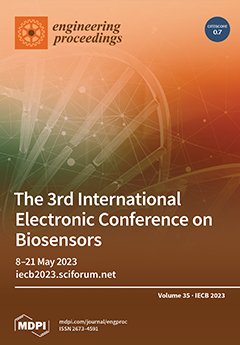Currently, dietary supplements contain a wide range of non-specific concentrations of testosterone and/or its synthetic analogs, substances that are not permitted and that pose a risk to public health, which puts into perspective the need to evaluate and regulate the composition of these
[...] Read more.
Currently, dietary supplements contain a wide range of non-specific concentrations of testosterone and/or its synthetic analogs, substances that are not permitted and that pose a risk to public health, which puts into perspective the need to evaluate and regulate the composition of these products. The present project proposes a control tool based on the development of a biosensor using aptamers as bio-recognition elements. The aptamer is a specific sequence of oligonucleotides with can fold into unique three-dimensional structures that interact with the analyte (testosterone and analogs). Integrally, it is proposed that the aptamers are coupled with gold nanoparticles functioning as a census and signal transduction system conducing to a biosensor with high sensitivity and selectivity and rapid response. In this work, modeling and molecular docking tools were used to evaluate the folding and structural stability of the aptamers. It is essential to carry out complete in silico analysis for the bio-recognition system and to evaluate the stability of the proposed aptamers with variations in the medium, allowing one to determine the conditions and adaptations necessary for the experimental analysis, design, and operation of the biosensor. On the other hand, evaluating the affinity and identifying the types of interactions between the aptamer and analyte allows us to locate the best candidate for the proposed aptamers. The stability of a set of nine sequences with proven interaction with testosterone was evaluated under different conditions, specifically, folding temperature (8.0 °C, 20 °C, and 30 °C), [Na
+] (1.0 mm M, 50 mM, and 150 mM) and [Mg
2+] (1.0 mm M, 2.0 mM, 3.0 mM, and 4.0 mM), with the MFold web server, RNA Composer, and PyMOL. The affinity and molecular interaction assays were carried out between each of the aptamers and three analytes: testosterone, testosterone undecanoate, and androstenedione using Auto dock Vina, Chimera, PyMOL, and Discovery Studio. The results showing stability and conformational changes in the aptamers allow us to conclude that the aptamers (T6, T5.1, and TESS1) are compatible with the conditions used in run tests and have high affinity for testosterone, the interactions of which are mainly established through non-covalent and hydrogen bonds.
Full article




